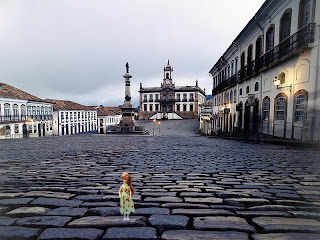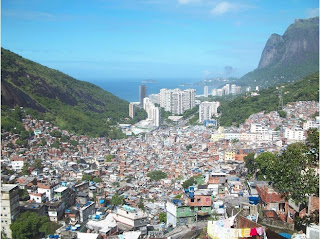MJ loved to know she can proceed with her Brazil tour, because today we spent the day in Natal, in Rio Grande do Norte state! The city got this name ('Natal' means Christmas in Portuguese) because the first settlers arrived here on December 25th 1599.
Natal é um lugar muito 'perigoso'... Quem vem prá ca visitar quer ficar de vez, um perigo!... hahaha...Situada no ponto mais extremo leste do continente, e sendo o ponto mais próximo da Europa no Brasil, mesmo estando apenas 5 graus ao sul da linha do equador, recebe o tempo todo uma brisa amena e fresca do oceano, o que lhe confere uma temperatura agradabilíssima e o ar mais puro de toda a América do Sul!
The thing is that Natal is a very 'dangerous' place... Whoever comes here to visit develops an 'urge' to stay forever, really dangerous!.... hahaha.... Located on the extreme eastern point of the continent, and being the closest point to Europe and Africa, and even though it lies just 5 degrees below the Equator line, there is a constant and pleasant breeze coming from the ocean. This grants the city a very pleasant temperature and the purest and most renewed air of all South America!
Uma das características mais marcantes de Natal são suas dunas de areia, sempre sendo movidas pelo vento. Passear pelas dunas, especialmente em Genipabu, é quase um passeio obrigatório, e muito divertido!!! Você pode optar por um passeio pacato no lombo de jegues, um passeio mais exótico no dorso de um dromedário (isso mesmo!) ou um mais radical e emocionante a bordo de um buggy. Todos são garantia de momentos inesquecíveis e paisagens belíssimas.
One of the most striking features of Natal is the sand dunes, always being 'moved around' by the wind. A ride up and down the dunes, specially in Genipabu beach, is almost a 'must do', and a lot of fun too!!! You can choose between a calm and easy ride on the back of a donkey, a more exotic one on the back of a dromedary (a one-humpback camel) (yes, you read it correctly!) or a more extreme and thrilling one on the back seat (sort of speak) of a 'buggy'. Either way unforgettable moments and breathtaking landscapes are guaranteed.
 |
| Ó céus! Viemos parar on Sahara? Não... é um passeio de dromedário pelas dunas... OMG, are we in the Sahara? Nope! It's just a ride on the back of dromedaries across the dunes.... |
 |
| Pode não parecer, mas sua adrenalina vai a mil! It might not seem so, but it's better than a roller coaster ride! |
 |
| Vista maravilhosa, não? Wonderful view, eh? |
It's also mesmerizing to watch local artisans creating their master-pieces using colored sand. They make landscape 'paintings' inside bottles of all sizes. Several sand shades and colors are natural and extracted in the area. It's almost irresistible to buy at least one and take it home as a souvenir... or several!
 |
| MJ está admirada com o talento do artista. MJ is in awe with the artisan skill. |
Aproveitando uma das praias, você poderá se surpreender em algum momento com um vôo rasante de um jato da força aérea, quase quebrando a barreira do som! (quase?...) É que em Natal, um dos quatro lugares mais estratégicos do mundo segundo a NASA, tem a "Barreira do Inferno", uma base da Aeronáutica, e o primeiro centro de lançamento de foguetes espaciais da América do Sul, inaugurada em 1965. Hoje, realiza pesquisas aeroespaciais e visitas guiadas.
While enjoying the beaches you can be surprised by a sudden very low flight of an air-force jet, almost breaking the sound barrier! (almost?...) That's because Natal is one of the four most strategic geographic places on the planet, according to NASA. And therefore our Air Force built there its base for jets and rocket launching in 1965, called "Barreira do Inferno" (Hell Barrier). Nowadays it's an aerospace research center and it also offers guided tours.
 |
| Caramba, você viu isso? Wow, did you see that? |
 |
| A "nasa" brasileira... The Brazilian version of 'nasa' |
Closer to downtown there is another very special touristic place one mustn't miss: the largest cashew tree in the world! Due to two genetic anomalies in one tree planted in 1888, its branches grow horizontally. The weight makes them go down until they touch the ground. The other anomaly makes those branches develop new roots, and new branches grow from there. This single tree covers an area of about 91,500 square feet, producing something between 70 to 80 thousand cashews each year! Though cashew the fruit is not among my favorite ones, its juice, ice-cream, and other delicacies made of it are very popular in Brazil. Nevertheless, MJ and I absolutely L-O-V-E cashew nut! There's nothing better to go along a 'caipirinha' drink... :)
 |
| Esta área verde toda no centro da foto é UMA árvore só!!! All this green area in the center is only ONE tree!!! |
 |
| Caju, a fruta! Cashew, the fruit! |
 |
| Então... onde estão as castanhas? So... where are the cashew nuts? |
One of the most interesting options to visit downtown is the 'Centro de Turismo de Natal', with several stores that sell the local exquisite craft: lots of embroidered, tattered, crocheted pieces, all magnificent and very delicate. Oh, what a temptation!...
 |
| Uma linda caisa de taípa em miniatura... A beautiful example of a local rustic house, in miniature (unknown scale) |
By the end of the afternoon, on the way back to the hotel, we visited the "Forte dos Reis Magos" (Wise Men Fort). It owes its name to the day it was finished. Built in 1598 in the shape of an irregular 5 pointed star, despite its excellent strategic location, it wasn't enough to prevent the invasion by the Dutch in 1633. But it is a very beautiful construction, which reminded MJ of the buildings she has recently seen in Greece. To me it reminds more of a Berber influence, but we both agreed its very beautiful and that the view from it is incomparable!
Enquanto decidimos se ficamos aqui de vez ou se seguimos em frente, rsrs... uma foto do morro do careca, onde as pessoas se divertem deslizando na duna como se fosse um gigantesco tobogã ou escorregador. Tirada do deck da piscina do hotel. Ok, podem ficar com inveja agora, hahahaha!...
While we decided if we'd stay here forever or if we'd move on to the next stop of our journey (big grin...) I took a picture of the 'Morro do careca' (Bald Hill), where people love to go and slide down as if they were on a toboggan or a giant playground sand-slide. This one was taken from the pool deck of our hotel. Ok, NOW you can envy us, lol!!!




































